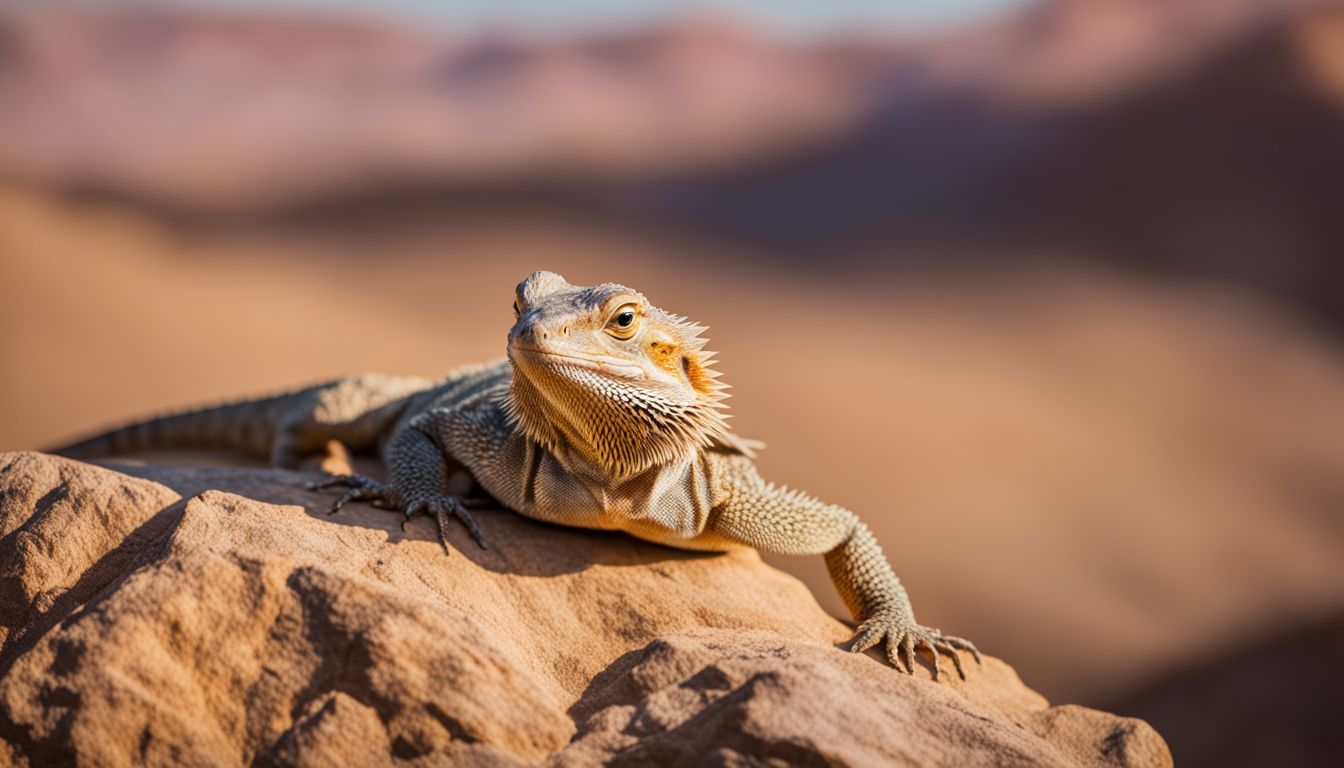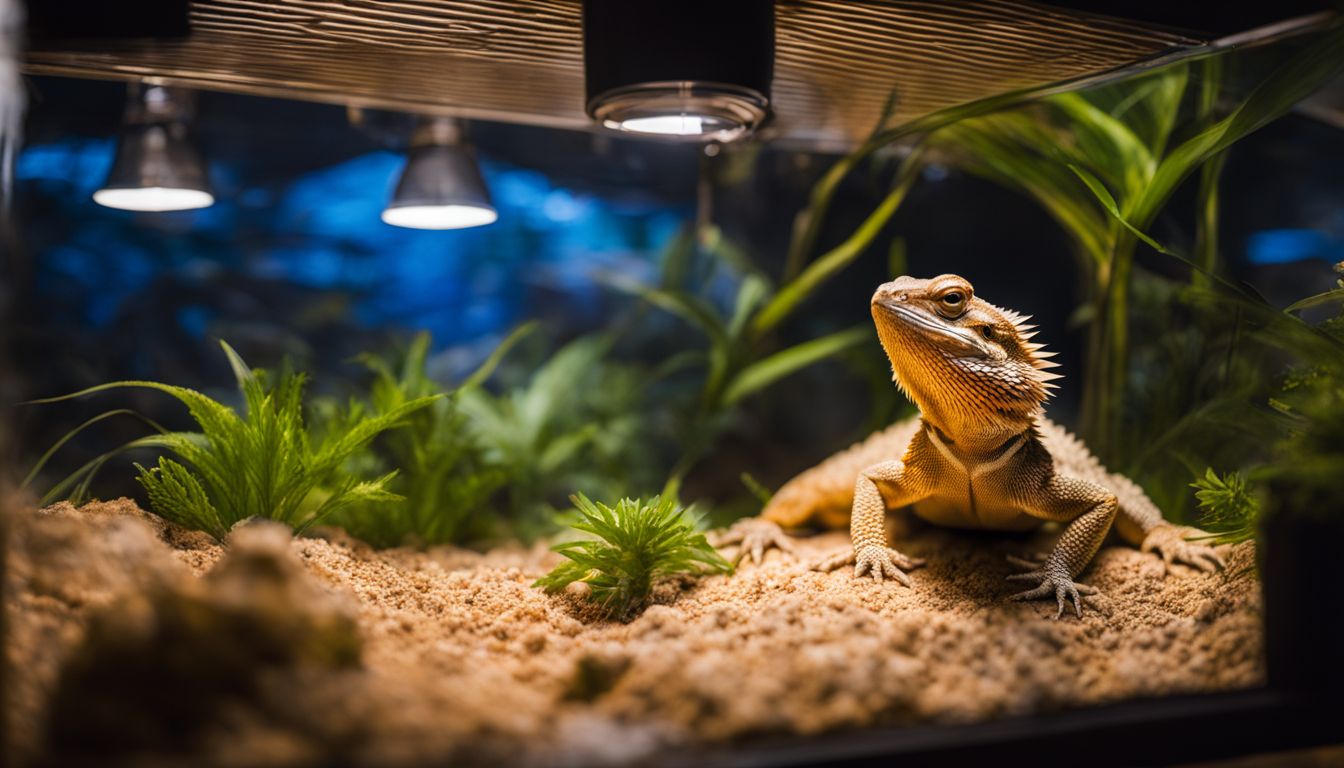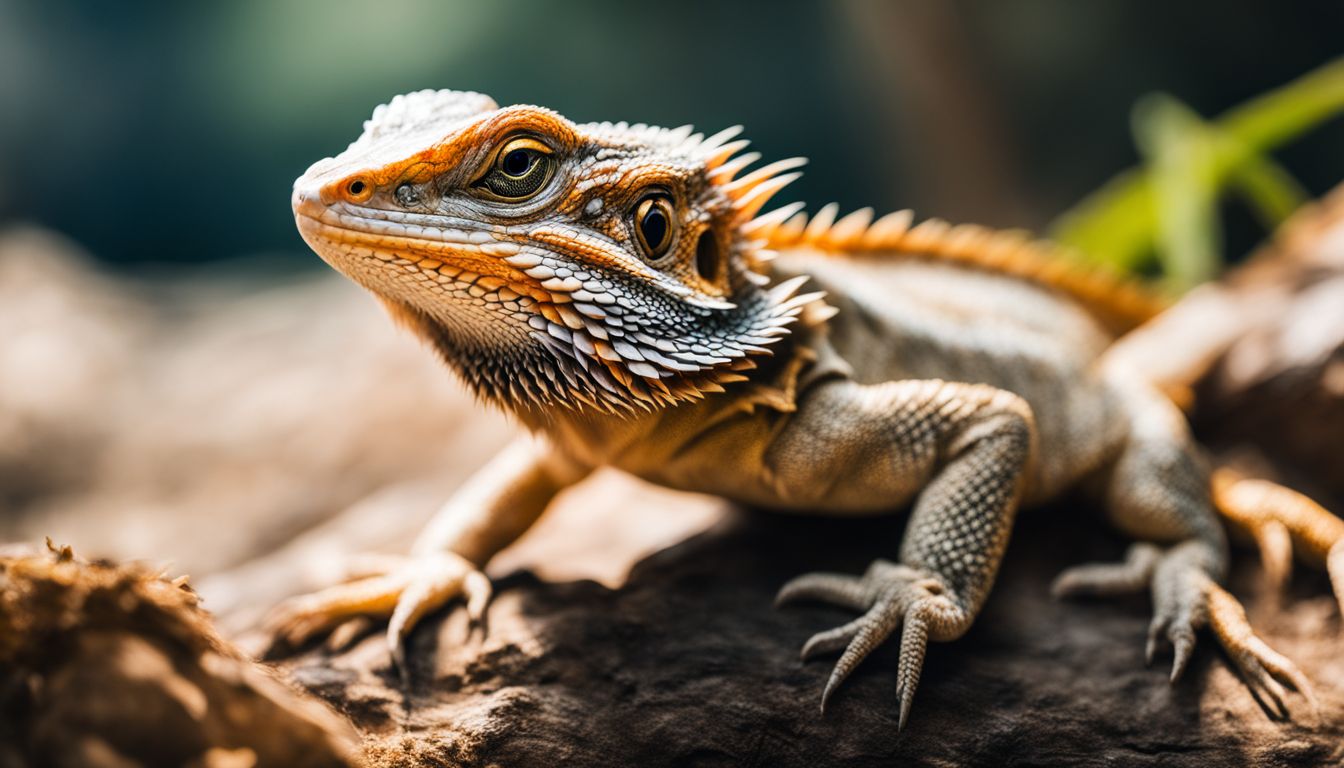Have you noticed your bearded dragon running around like crazy lately? You’re not alone. Many owners report this behavior, often linked to stress or boredom. This blog will explore reasons behind such erratic actions and offer solutions to calm your pet.
Let’s make them happy again.
Understanding Bearded Dragon Behavior

Bearded dragon behavior includes glass surfing and running into objects. These actions can indicate stress, boredom, dehydration, or heat exposure.
Glass Surfing
Glass surfing looks like your bearded dragon is trying to walk or run up the sides of their tank. It often means they feel stressed or bored. Sometimes, the tank might be too small for them, making them want more space to roam.
This behavior can also come with head bobbing, showing they’re not just playing around.
Stress or boredom triggers glass surfing in many reptiles, including bearded dragons. To keep them happy and healthy, it’s important to check if their home is big enough and interesting enough for them.
Next up, let’s explore what happens when your beardie starts running into objects inside their tank.
Running into Objects
Bearded dragons might charge headlong into walls or other objects in their tanks. This can be due to poor depth perception and misjudging distances. These lizards see the world differently than we do, making it hard for them to tell how far away something is.
A clear tank wall might seem like an open path to them, leading to unexpected collisions.
Another factor that contributes to this erratic behavior is the substrate used in their enclosure. Some materials or setups can confuse a bearded dragon, causing them to act out by running around wildly.
Ensuring your pet has a well-arranged terrarium with appropriate substrate will help minimize these risky dashes. It’s all part of creating a safe and comfortable habitat that mimics their natural environment as closely as possible.
Possible Reasons for Erratic Behavior

Your bearded dragon may exhibit erratic behavior due to stress, boredom, dehydration, or excessive heat exposure. Understanding these potential factors can help you address your pet’s well-being effectively.
Stress
Stress in bearded dragons shows up in many ways, including stress marks and erratic movements. Loud noises, sudden environmental changes, and aggression from others can trigger this anxiety.
Glass surfing—a frantic attempt to climb the tank walls—is a clear sign your bearded friend feels stressed. Poor diet, improper tank setup, and even mating season add to their distress.
Experts suggest several calming techniques to ease stress. Creating a peaceful environment is key—think quiet spaces with minimal disruption. Adjusting the habitat temperature and ensuring proper nutrition also play vital roles in reducing anxiety triggers.
By addressing these environmental stressors head-on, one can significantly lower levels of anxious behavior in bearded dragons, fostering a more serene atmosphere for them to thrive.
Boredom
When bearded dragons experience stress, it can also lead to boredom. This can manifest as restlessness, running back and forth alongside their enclosure, or frequently pulling themselves up on hind legs.
Such behaviors indicate that your pet may be feeling ennui or lethargy.
Lethargy and disinterest in their usual activities are signs of boredom in bearded dragons. They might exhibit frustration by displaying repetitive actions like glass surfing and running into objects within their habitat.
Dehydration
When bearded dragons don’t get enough water, they can become dehydrated. Dehydration in bearded dragons can lead to serious health problems like kidney failure, impaction, and digestive issues.
Signs of dehydration include loose, saggy skin, lack of energy, and muscle weakness. It’s important to pay attention to these signs and provide fresh water for the bearded dragon to drink.
Coaxing a dehydrated bearded dragon with a bowl of water in their tank may help alleviate the issue.
Proper hydration is crucial for bearded dragons’ overall well-being. When a beardie is not getting enough fluids through food or baths, it’s essential to take action promptly by ensuring access to clean drinking water at all times.
Heat Exposure
Improper heat exposure can cause stress and erratic behavior in bearded dragons. It’s crucial to regulate the temperature in their terrarium to prevent overheating, which can lead to lethargic behavior and heat-related illness.
Be on the lookout for signs of discomfort, such as continuous glass surfing or lack of energy, as these may indicate that your bearded dragon is struggling with excessive heat. Ensure proper heating and environmental regulation in their habitat to maintain a comfortable and stress-free environment for your pet.
Be mindful of climatic conditions and monitor the terrarium temperature regularly to prevent heat stress in bearded dragons. Providing a well-regulated environment will help manage potential issues related to improper heat exposure, ensuring your pet remains healthy and active.
Signs of Dehydration in Bearded Dragons
Be on the lookout for color changes and decreased energy levels in your bearded dragon, crucial signs of dehydration. To learn more about keeping your pet healthy, delve into our guide!
Change in Color
When a bearded dragon experiences dehydration, its skin may change color. Look for loose, saggy, wrinkly skin and loss of skin elasticity as signs. These changes in color can also indicate temperature regulation and social signals among bearded dragons.
If your pet displays a red color, it might signal illness. Research shows that bearded dragons can adjust the color of specific body parts to different stimuli.
Lack of Energy
Lack of energy in bearded dragons might indicate dehydration or kidney problems. Low energy and muscle weakness are signs of dehydration in these reptiles. It’s crucial to monitor their activity and hydration levels, as lack of energy could signal an underlying health issue that needs attention.
Keep an eye on their water intake, urination frequency, and overall well-being to ensure they stay healthy and active.
Thirst, dry skin, sunken eyes, electrolyte imbalance, lethargy—all could point towards a dehydrated bearded dragon. Stay vigilant about their hydration levels and take action promptly if you notice any signs of low energy or dehydration in your pet lizard.
Diet and Nutrition’s Role in Behavior
A balanced diet is crucial for a bearded dragon’s behavior. Nutritious food helps prevent abnormal behavior and lethargy, keeping them healthy and active. Reptile nutrition plays a significant role in their overall health and wellbeing, impacting their feeding habits and energy levels.
It’s essential to provide the right dietary needs, ensuring they receive the nutritional balance necessary for optimal behavioral health.
Diet and nutrition directly influence a bearded dragon’s behavioral issues, making it vital to maintain a balanced diet. Poor nutrition can contribute to erratic behavior, affecting their mood and activity levels.
To foster healthy behavior in bearded dragons, offering a well-rounded diet is key – one that meets their dietary requirements and supports their overall well-being.”.
How to Calm a Stressed Bearded Dragon
To calm a stressed bearded dragon, ensure it has access to proper hydration and maintain the environmental temperature. Also, provide a comfortable habitat with adequate hiding spots for security.
Proper Hydration
Bearded dragons need proper hydration to stay healthy. Dehydration can cause them to become lethargic and show signs like sunken eyes and wrinkled skin. To keep your pet hydrated, provide a shallow dish of water for them to drink from regularly.
Moderate dehydration may require you to offer water directly, such as through a syringe or dropper. Be observant of any changes in their behavior and appearance, as maintaining proper hydration is crucial for the overall well-being of your bearded dragon.
Adequate Environmental Temperature
Maintaining the right temperature in your bearded dragon’s habitat is crucial for their well-being. Bearded dragons rely on their environment to regulate their body temperature, so it’s essential to create a comfortable space for them.
Ensure there is a proper temperature gradient across the enclosure, with a warm basking spot and cooler areas. Additionally, consider using heating lamps or pads to provide the optimal environmental temperature necessary for your pet reptile.
For humidity level, aim for around 30-40% in the habitat. The lighting setup should include UVA and UVB bulbs to mimic natural sunlight exposure and aid in calcium absorption. By maintaining these elements, you can help prevent stress and erratic behavior while promoting your bearded dragon’s overall health and comfort within its environment.
Providing a Comfortable Habitat
To ensure that your bearded dragon feels comfortable and at ease, it’s crucial to create an optimal habitat. Start with a spacious terrarium or enclosure that allows them to roam and move freely.
Add plenty of hiding spots and climbing structures for mental stimulation and relaxation. Maintain the proper temperature gradient within the environment, providing warmth on one end and cooler areas on the other.
This will help replicate their natural habitat and keep them calm.
In addition, include suitable substrate for burrowing, as this mimics their wild behavior and helps reduce stress. Proper lighting is essential; use UVB bulbs to simulate natural sunlight, promoting overall well-being in your pet reptile.
By maintaining a comfortable habitat with adequate space, temperature, lighting, and enrichment options like hiding places and climbing materials, you can help ensure your bearded dragon feels relaxed and content in its surroundings.
Conclusion
In conclusion, your bearded dragon’s erratic behavior may signal stress, boredom, or health issues. Ensure a suitable habitat with proper temperature and enrichment. Monitor their diet and seek veterinary advice if concerns persist.
Discover more about your bearded dragon’s dietary needs and whether beetroot is a safe option for them.
FAQs
1. Why is my bearded dragon running around like crazy?
Bearded dragons may run around due to exercise, exploration, or stress.
2. Is it normal for a bearded dragon to act hyperactive?
Yes, it’s normal for bearded dragons to exhibit periods of high activity, especially during their active hours.
3. How can I calm down my hyperactive bearded dragon?
Providing a comfortable and secure environment with proper temperature and hiding spots can help calm down a hyperactive bearded dragon.
4. What are signs that indicate my bearded dragon’s behavior is abnormal?
Abnormal behaviors in bearded dragons include constant pacing, glass surfing, or signs of distress such as black beard display or excessive puffing.
5. When should I seek professional help for my hyperactive bearded dragon?
If your bearded dragon’s hyperactivity persists despite environmental adjustments or if you notice other concerning symptoms, consulting a reptile veterinarian is recommended.




